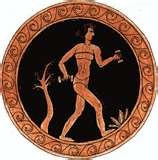 These establishments were used for training youths in boxing and wrestling and were also frequented by Socrates and other philosophers. This article contains a discussion of the locations of the palaestrae (wrestling schools) that are known to have existed in Athens, and the the function of these establishments.
These establishments were used for training youths in boxing and wrestling and were also frequented by Socrates and other philosophers. This article contains a discussion of the locations of the palaestrae (wrestling schools) that are known to have existed in Athens, and the the function of these establishments.
Locations
Palaestrae were an integral part of larger gymnasia (areas for general physical training and athletics) and are attested for the three well-known gymnasia areas of Athens (the Academy [Hyperides, Demosthenes, fr. 6], Cynosarges [Diogenes Laertius, 6.30.8 and Aelian, True History 8.14.3], and Lyceum [Pseudo-Plutarch, Lives of the Orators 841d and 843f]). These schools for training in combat sports also existed separately from gymnasia in the city of Athens itself and in the countryside.
As a result of the difficulty of archaeological exploration amidst the urban sprawl of modern Athens, even the general locations of most of the palaestrae outside the major gymnasia areas of Archaic and Classical Athens and Attica are not known with certainty. Only two urban Athenian palaestrae may be roughly located: the palaistra of Taureas and the palaistra where Mikkos was a sophist. The palaistra of Taureas is said by Plato ( Charmides 153a, Lucian, Parasite 43) to have been opposite the sanctuary of Basile. Neither the sanctuary nor the palaistra may be located with any certainty, however, despite Travlos’ confident statement that a boundary stone marking an unnamed sanctuary near the corner of modern Syngrou Blvd. and Hatzichristou St. refers to the sanctuary of Basile (Travlos, PDA 332 and fig. 435). The palaistra where Mikkos taught is said by Plato to have been near the Panops fountain, which has been placed in the neighborhood of the Diochares Gates in Northeast Athens (Ritchie, “Lyceum” 253-254 and Travlos, PDA 159-160).
There were palaestrae in the Attic countryside as well. For example, the sanctuary of Artemis at Brauron had both a gymnasium and a palaestra (SEG XL 91). Kephissia possessed a palaistra ( SEG XXXII 147) and it is likely that many of the other demes, especially large ones like Acharnae and Aphidna, had their own as well. There is also the case of the so-called “Palaestra of Cercyon,” a palaestra belonging to a mythical person, but associated with an actual place along the Eleusis-Megara road (Bacchylides 18.26, Scholia of Arethas on Lucian 21.21). The travel writer Pausanias (1.39.3) himself visited the site.
Other palaestrae mentioned by the ancient sources include the place where Ariston of Argos trained Plato as a youth (Apuleius, On Plato 1.2 and Suda, s.v. Platon), the palaestra of Hippocrates (Pseudo-Plutarch, Lives of the Orators 837e) where Isocrates died in 337 BC, and the palaestra of Sibyrtios (Plutarch, Alcibiades 3) where a follower of Alcibiades was killed. For the other palaestrae mentioned by the ancient sources there is no indication of place or even number (Kratinos, fr. 176, Lysias, fr. 6.1 Teisis, Theophrastus, Characters 7.5, Aelian Varia Historia 4.24.2, Pollux, Onomastica 2.13); some of these unnamed palaestrae may refer to the same structures or they may be independent facilities.
The palaestrae in the Academy, Brauron, Cynosarges, and Lyceum would have come under the superintendence of the cult officials who oversaw the larger gymnasia areas. Other palaestrae appear to have been overseen and regulated by public officials, such as the paidotribes or epistates (Aeschines, Against Timarchus 10). The only firm evidence for the private ownership of a palaestra comes from Theophrastus, who appears in this instance to be describing in extreme and unflattering terms a small, poorly constructed home palaestra (Theophrastus, Characters 21.15-16).
W. Morison, “Attic Gymnasia and Palaistrai: Public or Private?” The Ancient World 31.2 (2000) 140-143.
W. Morison, “An Honorary Deme Decree and the Administration of a Palaistra in Kephissia,” Zeitschrift f






























